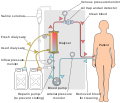Hemodialysis
Hemodialysis is a medical procedure used to remove waste and excess fluid from the blood when the kidneys are not able to adequately do so. It is one of the most common treatments for advanced, end-stage kidney disease.
Overview[edit]
Hemodialysis involves circulating the patient's blood outside of the body through a machine known as a dialyzer or artificial kidney. The dialyzer has two parts: one for the patient's blood and another for a wash fluid known as dialysate. A thin membrane separates these two parts. Blood cells, protein and other important blood components are too large to pass through the membrane, but waste products and excess fluid move from the blood to the dialysate.
Procedure[edit]
Before starting hemodialysis, the patient needs a vascular access, which is a way to reach the patient's bloodstream. There are three types of vascular access: arteriovenous (AV) fistula, AV graft, and venous catheter.
During hemodialysis, the patient's blood is pumped through soft tubes to the dialyzer. The dialyzer removes waste and extra chemicals and fluid from the blood. Then the cleaned blood flows through another set of tubes and back into the body.
Risks and Complications[edit]
Like any medical procedure, hemodialysis has potential risks and complications. These can include low blood pressure, anemia, bone diseases, high blood pressure, heart disease, nerve damage, infection, and blockage or clotting of the vascular access.
Alternatives[edit]
Alternatives to hemodialysis include peritoneal dialysis and kidney transplant. The choice of treatment depends on the patient's health condition, lifestyle, and personal preference.
See Also[edit]
Ad. Transform your life with W8MD's Budget GLP-1 injections from $75


W8MD offers a medical weight loss program to lose weight in Philadelphia. Our physician-supervised medical weight loss provides:
- Weight loss injections in NYC (generic and brand names):
- Zepbound / Mounjaro, Wegovy / Ozempic, Saxenda
- Most insurances accepted or discounted self-pay rates. We will obtain insurance prior authorizations if needed.
- Generic GLP1 weight loss injections from $75 for the starting dose.
- Also offer prescription weight loss medications including Phentermine, Qsymia, Diethylpropion, Contrave etc.
NYC weight loss doctor appointmentsNYC weight loss doctor appointments
Start your NYC weight loss journey today at our NYC medical weight loss and Philadelphia medical weight loss clinics.
- Call 718-946-5500 to lose weight in NYC or for medical weight loss in Philadelphia 215-676-2334.
- Tags:NYC medical weight loss, Philadelphia lose weight Zepbound NYC, Budget GLP1 weight loss injections, Wegovy Philadelphia, Wegovy NYC, Philadelphia medical weight loss, Brookly weight loss and Wegovy NYC
|
WikiMD's Wellness Encyclopedia |
| Let Food Be Thy Medicine Medicine Thy Food - Hippocrates |
Medical Disclaimer: WikiMD is not a substitute for professional medical advice. The information on WikiMD is provided as an information resource only, may be incorrect, outdated or misleading, and is not to be used or relied on for any diagnostic or treatment purposes. Please consult your health care provider before making any healthcare decisions or for guidance about a specific medical condition. WikiMD expressly disclaims responsibility, and shall have no liability, for any damages, loss, injury, or liability whatsoever suffered as a result of your reliance on the information contained in this site. By visiting this site you agree to the foregoing terms and conditions, which may from time to time be changed or supplemented by WikiMD. If you do not agree to the foregoing terms and conditions, you should not enter or use this site. See full disclaimer.
Credits:Most images are courtesy of Wikimedia commons, and templates, categories Wikipedia, licensed under CC BY SA or similar.
Translate this page: - East Asian
中文,
日本,
한국어,
South Asian
हिन्दी,
தமிழ்,
తెలుగు,
Urdu,
ಕನ್ನಡ,
Southeast Asian
Indonesian,
Vietnamese,
Thai,
မြန်မာဘာသာ,
বাংলা
European
español,
Deutsch,
français,
Greek,
português do Brasil,
polski,
română,
русский,
Nederlands,
norsk,
svenska,
suomi,
Italian
Middle Eastern & African
عربى,
Turkish,
Persian,
Hebrew,
Afrikaans,
isiZulu,
Kiswahili,
Other
Bulgarian,
Hungarian,
Czech,
Swedish,
മലയാളം,
मराठी,
ਪੰਜਾਬੀ,
ગુજરાતી,
Portuguese,
Ukrainian









